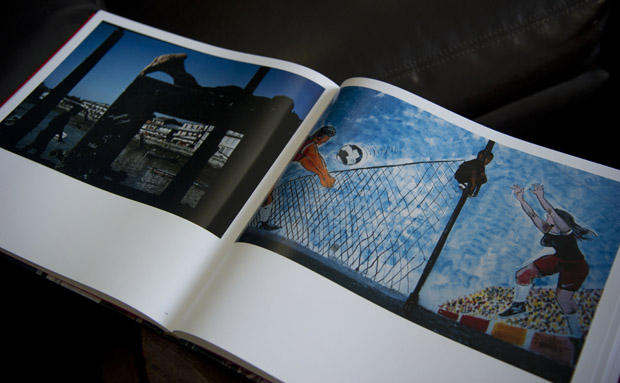There are endless amounts of photography books available these days, and an endless line of photographers behind them. Amongst those are some of the elite photographers, and once in a while they create a body of work that leaves you absolutely speechless. One of those photographers (at least for me) is Alex Webb.
Webb’s latest book ‘The Suffering of Light“ is the first comprehensive monograph charting the career of acclaimed American photographer. Gathering some of his most iconic images, many of which were taken in the far corners of the earth, this exquisite book brings a fresh perspective to his extensive catalog. Recognized as a pioneer of American color photography since the 1970s, Webb has consistently created photographs characterized by intense color and light. Alex Webb joined the prestigious agency ’Magnum Photos‘ in 1976 and became a full Member in 1979.
PHYSICAL APPEARANCE
The book’s physical appearance is first class. It comes in hardcover and bound very well, giving a good feeling of long-lasting.The covers are thick and of good material, with a nice touch of orange woven material on the right side of the book. The quality of the printing is wonderful with vibrant and accurate colors, virtually leaping off the page and into your mind for at least the next 24 hours!
PUBLISHER
The book is published by Aperture; First Edition edition (May 31, 2011), and consists of 204 pages, featuring no less than 119 pictures, with an extra 7 images along with the ‘Afterword’ by Geoff Dyer. The front and back cover share the one picture stretched across the entire book which is a nice eye catching image.
Attached to each picture is a basic caption with the location the picture was taken and the year it was taken. The book’s content reads very smoothly with most pages opening up to a picture on the right page with a black white on the left. Every now and then there are pictures on both pages which is a nice change.
ABOUT THE PICTURES AND TECHNIQUE
Any book can be made of good quality materials but we all know in a photography book, the pictures must deliver and Webb’s work delivers BIG TIME. Firstly, if you’re not familiar with Webb’s work, it’s important to know that when looking at his pictures, you don’t rush. You need to take your time and scan every picture from edge to edge because there’s a good chance you’ll miss something important if you don’t. Webb’s pictures are often complex and layered. By this, I mean his work is carefully structured and he’s thinking much deeper than what’s happening right in front of him. When composing, it’s obvious that he’s creating layers by putting himself in positions where he has a close foreground, medium foreground, a middle ground and a background. This technique requires an enormous amount of patience and an incredible eye for detail and timing. Combined with the right light, Webb is able to create masterpieces of the simplest scenarios that go unnoticed to the average human being.
Webb’s understanding of natural light and how to read light is of the highest standard and is evident by the high contrast results and impressive exposure accuracy. He achieves this by choosing his shooting around times where the sun is lower, providing deeper shadows and super high contrast. Even in lower light, Webb is able to come out with work that evenly matches his work in daylight, that is punchy and full of life. It’s also important to point out Webb’s ability to blend into a crowd and become part of the action. It’s impossible to take great pictures with such poise unless you can understand how to mix in with the people and the environment. This is a typical strength of documentary and street photographers that Webb has mastered.
Lastly I’d like to point out one very important factor in the success of Webb’s imagery – the questions his pictures ask. As viewers of pictures, we are effectively outsiders looking into the life and experiences of a photographer. Like any good movie, a good picture story is told with enough information to satisfy our basic need for understanding, but the best movies are those that leave out information, forcing us to ask ourselves questions, where there are no answers. This forces us to fill in the blanks with our imagination. For example, most photographers may find it to be second nature to show a person’s face in a photograph, but for Webb, it’s not an obvious thought process because it doesn’t always make for a better picture. It’s clear that Webb saves some of the answers for himself only, and the rest of us have to fill in the gaps – but this is what makes Webb’s work so intricate and compelling.
Front
Back
DO I RECOMMEND IT?
Absolutely! It’s rare to come across a book that delivers that WOW factor on every page, from start to finish, so don’t hesitate, go order it now!
WHO DO WE RECOMMEND IT TO?
If you love documentary photography, street photography, abstract with human elements, this is for you.
HOW DO YOU GET IT?
The simplest way is through Amazon.com who offer their prime next day or two day delivery service. This is what i used and I’m very happy with the product and service.






